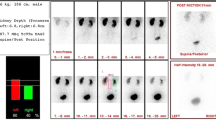Abstract
Purpose
To analyse the influence of CT-based depth correction in the assessment of split renal function in potential living kidney donors.
Methods
In 116 consecutive living kidney donors preoperative split renal function was assessed using the CT-based depth correction. Influence on donor side selection and postoperative renal function of the living kidney donors were analyzed. Linear regression analysis was performed to identify predictors of postoperative renal function.
Results
A left versus right kidney depth variation of more than 1 cm was found in 40/114 donors (35%). 11 patients (10%) had a difference of more than 5% in relative renal function after depth correction. Kidney depth variation and changes in relative renal function after depth correction would have had influence on side selection in 30 of 114 living kidney donors. CT depth correction did not improve the predictability of postoperative renal function of the living kidney donor. In general, it was not possible to predict the postoperative renal function from preoperative total and relative renal function. In multivariate linear regression analysis, age and BMI were identified as most important predictors for postoperative renal function of the living kidney donors.
Conclusions
Our results clearly indicate that concerning the postoperative renal function of living kidney donors, the relative renal function of the donated kidney seems to be less important than other factors. A multimodal assessment with consideration of all available results including kidney size, location of the kidney and split renal function remains necessary.



Similar content being viewed by others

References
Lennerling A, Lovén C, Dor FJ et al (2013) Living organ donation practices in Europe—results from an online survey. Transpl Int 26:145–153
Halleck F, Diederichs G, Koehlitz T et al (2013) Volume matters: CT-based renal cortex volume measurement in the evaluation of living kidney donors. Transpl Int 26:1208–1216
Oh CK, Yoon SN, Lee BM et al (2006) Routine screening for the functional asymmetry of potential kidney donors. In: Transplant Proc, vol. 38, pp 1971–1973
Engelken F, Friedersdorff F, Fuller TF et al (2013) Pre-operative assessment of living renal transplant donors with state-of-the-art imaging modalities: computed tomography angiography versus magnetic resonance angiography in 118 patients. World J Urol 31:983–990
Wujanto MB, Lawson RS, Prescott MC et al (1987) The importance of using anterior and posterior views in the calculation of differential renal function using 99mTc-DMSA. Br J Radiol 160:869–872
Prigent A (1999) Consensus report on quality control of quantitative measurements of renal function obtained from the renogram: international consensus committee from the scientific committee of radionuclides in nephrourology. Semin Nucl Med 29:146–159
Gruenewald SM, Collins LT, Fawdry RM (1985) Kidney depth measurement and its influence on quantitation of function from gamma camera renography. Clin Nucl Med 10:398–401
Gault MH, Longerich LL, Harnett JD et al (1992) Predicting glomerular function from adjusted serum creatinine. Nephron 62:249–256
Levey AS, Bosch JP, Lewis JB et al (1999) A more accurate method to estimate glomerular filtration rate from serum creatinine: a new prediction equation. Ann Intern Med 130:461–470
Du Bois D, Du Bois EF (1989) A formula to estimate the approximate surface area if height and weight be known. 1916. Nutrition 5:303–313
Weinberger S, Baeder M, Scheurig-Muenkler C et al (2016) Optimizing scintigraphic evaluation of split renal function in living kidney donors using the geometric mean method: a preliminary retrospective study. J Nephrol 29:435–441
Lim J, Kong YG, Kim YK et al (2017) Risk factors associated with decreased renal function after hand-assisted laparoscopic donor nephrectomy: a multivariate analysis of a single surgeon experience. Int J Med Sci 14:159–166
Hew MN, Opondo D, Cordeiro ER et al (2014) The 1-year decline in estimated glomerular filtration rate (eGFR) after radical nephrectomy in patients with renal masses and matched living kidney donors is the same. BJU Int 113:E49–55
Lee SH, Kim DS, Cho S et al (2015) Comparison of postoperative estimated glomerular filtration rate between kidney donors and radical nephrectomy patients, and risk factors for postoperative chronic kidney disease. Int J Urol 22:674–678
Benoit T, Game X, Roumiguie M et al (2017) Predictive model of 1-year postoperative renal function after living donor nephrectomy. Int Urol Nephrol 49:793–801
Author information
Authors and Affiliations
Contributions
SW manuscript writing, CK data collection and management. LL manuscript editing. MB protocol/project development. NS data analysis. FF manuscript writing and editing.
Corresponding author
Ethics declarations
Conflict of interest
The authors declare that they have no conflict of interest.
Research involving human participants and/or animals
No human participants or animals were involved into this study.
Informed consent
Because of the retrospective analysis no informed consent were needed.
Rights and permissions
About this article
Cite this article
Weinberger, S., Klarholz-Pevere, C., Liefeldt, L. et al. Influence of CT-based depth correction of renal scintigraphy in evaluation of living kidney donors on side selection and postoperative renal function: is it necessary to know the relative renal function?. World J Urol 36, 1327–1332 (2018). https://doi.org/10.1007/s00345-018-2272-0
Received:
Accepted:
Published:
Issue Date:
DOI: https://doi.org/10.1007/s00345-018-2272-0



